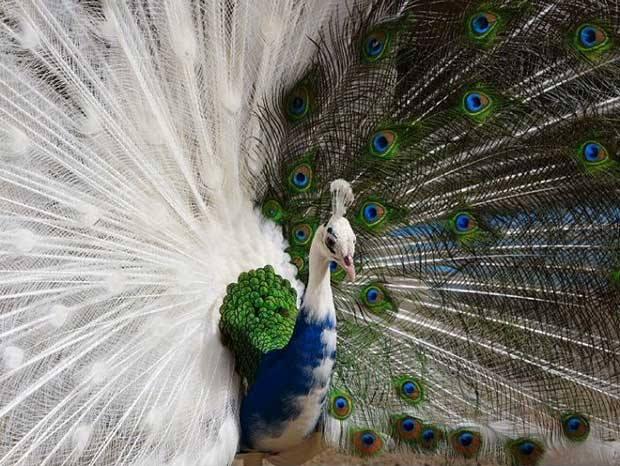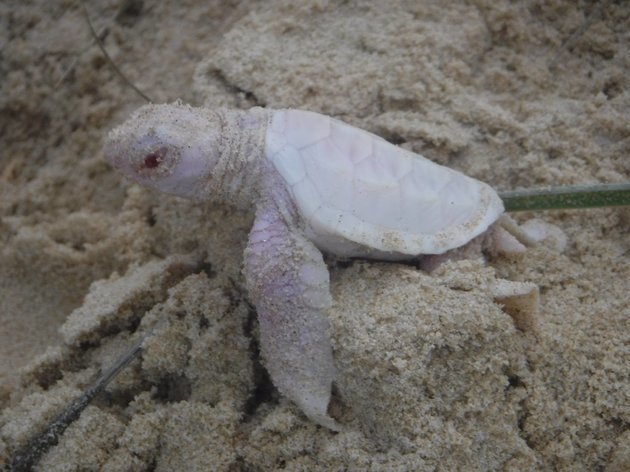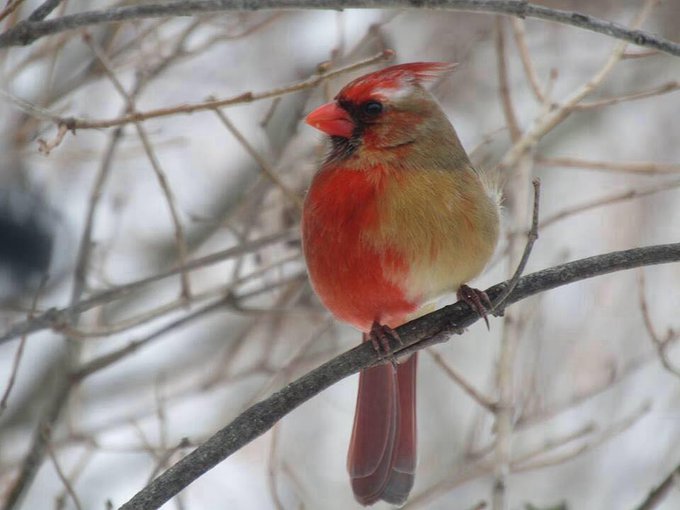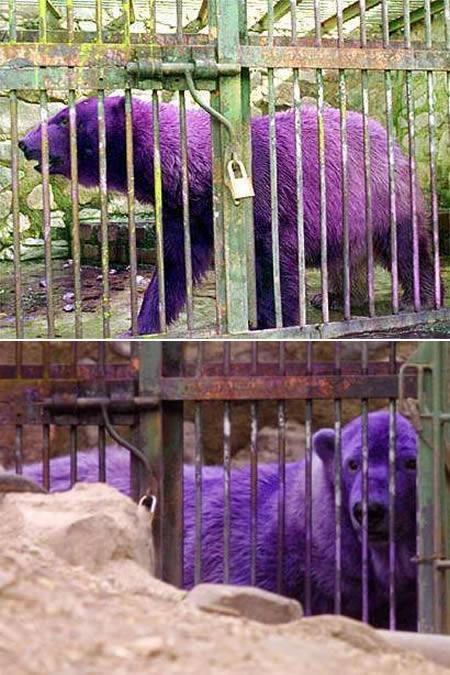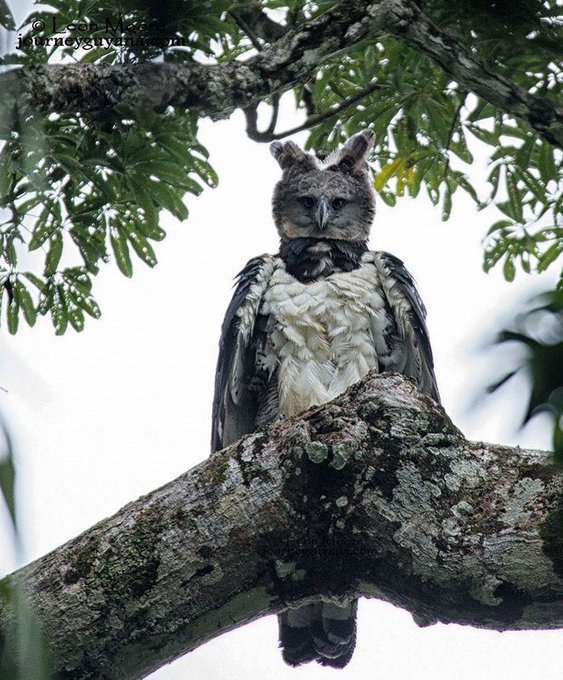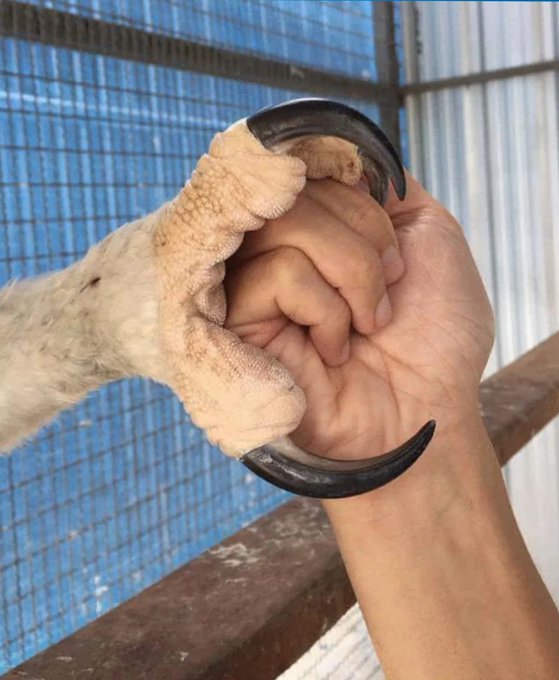The animal kingdom is far more colorful than you might imagine, and here are some of the world’s rarest creatures that definitely won the genetic lottery.
Melanistic Foxes
When you think of the world’s most beautiful wild animals, foxes probably don’t spring to mind. But have you ever seen a fox like the one on the image below?
This is the incredibly rare and majestic cross fox, which was once abundant in America until they were largely killed off in the late 19th century thanks to high demand for their unique fur.
Cross foxes are almost identical to red foxes, but they have a larger, bushier tail with more wool under their feet. The cross fox was given its name thanks to the long, dark stripe running down its back, intersecting another stripe to form a cross over the shoulders. Their incredibly unique coat is the result of a partially-melanistic variant. Melanistic is basically the opposite of albinism, meaning that an abundance of dark-colored pigment is produced under the skin. Although melanistic foxes make up about 30% of the Canadian fox population they’re still a very rare sight to see. But there’s an even more elusive kind: the
silver fox.
These mysterious foxes are a fully melanistic version of the cross fox created through years of breeding. They have a glossy black undercoat with a topcoat that looks like they've been dusted with silver, as well as some white coloring on the tip of their tails! One thing’s for sure: you’d be incredibly lucky to see one of these foxes raiding your bins!
King Cheetah
Notice anything out of the ordinary about the cheetah in the image below? Take a closer look at that magnificent coat when compared with its run-of-the-mill counterpart, and you’ll see what makes the so-called King Cheetah so well sought-after.
This stunning big cat is a variety of the regular cheetah with a rare mutation that produces cream-colored fur with large, blotchy spots and three distinctive dark, wide stripes extending from the neck down to the tail. At first, it was thought to be a different species altogether, before it was discovered that the fur pattern was actually caused by a recessive gene that promotes the over-production of melanin in the skin. Back in 1926, Major A. Cooper shot a king cheetah and noticed how the fur was thicker and darker than normal, so he named it after himself. Imagine, you kill an animal and then name it after yourself, that’s some nerve!

©BeAmazed
Thankfully, an English zoologist wasn’t impressed and renamed the animal Acinonyx Rex. Rex translates as ‘king’ in Latin, and the King Cheetah was born! This elusive big cat is actually one of the rarest animals in the world. There are only about 30-50 in the entire world. As few as 10 of those are thought to exist in the wild, while the others are in protected parks and wildlife reservations.
Pink Katydid
There is a pretty-pink variation in katydid, which are related to grasshoppers and crickets and mostly found in the tropics like the Amazon Rainforest. Usually, Katydids are green but some awesome pink variants were first described back in 1874! Since then, there has been intense discussion over the origins of their dazzling hue.

At the turn of the 20th century, Harvard entomologist Hubbard Scudder suggested that the pink coloring could be seasonal, meaning the normally-green insect would change colors with the Autumn leaves as the temperature drops. But this theory was debunked when myrmecologist William Morton Wheeler found bright-pink katydid nymphs in the prairies of Wisconsin and Illinois during the summer season of July 1907. Finally, the truth was revealed. These pimped-out bugs suffer from a genetic mutation controlled by recessive genes which is known as erythrism. This causes an absence of normal green pigment and/or excessive production of a red or pink pigment in the skin! Pink katydids are pretty hard to come by in the wild, which can partly be explained by the fact that hot-pink is probably not the best camouflage.
Albino Snake
Albinism, a condition where the melanin pigment, which controls skin, hair and eye color is not produced, doesn’t just affect us humans. Whether you’re afraid of snakes or not, there’s no denying that the albino serpents are seriously captivating!
But you’re unlikely to ever see one for yourself, because they’re some of the rarest creatures in the world. The reason why they’re so few-and-far between is actually pretty sad. In the wild, most snakes rely on camouflage, so they don’t become another animals dinner. But an albino snake, with its pearly-white skin, will stand out in its native habitat and will likely not last long enough to reproduce. What’s more, albinism often results in poor eyesight, which puts them at a disadvantage when hunting for food or avoiding danger. Albino animals are also more vulnerable to poachers look to capitalize on the booming demand for exotic pets derived from rare creatures. Basically, it’s a hard life being this pretty!
Blue Lobster
Lobsters caught off the Atlantic coast of North America aren’t usually very colorful. Instead, they tend to be a murky, greenish-brown. But in 2016, two fishermen off the coast of Nova Scotia made the news when they caught not one but two vivid blue lobsters in quick succession just 150km apart.

Netting a blue lobster is usually considered a sign of good fortune among the regions fishermen, so it seems like these guys got double lucky! In fact, the probability of the creatures having this coloring is widely touted as being around one in two million. Considering around 200 million lobsters are caught in the North Atlantic every year, that equates to about 100 blue ones turning up annually. Blue lobsters get their dazzling cobalt hue thanks to a genetic abnormality that causes them to produce more of a certain protein than regular lobsters. But it turns out blue isn’t even the rarest colored crustacean you can hope to catch. Back in 2011, two Dorset fishermen hit the ultimate jackpot when they netted an
albino or ‘crystal’ lobster near Portland Bill in Weymouth. These ghostly lobsters are caused by a genetic condition called leucism, which leaves them with no pigment in their shells.
Without any camouflage, it’s incredible that this stunning crustacean hadn’t already been eaten by a predator like a shark. In fact, the odds of finding this bad boy are estimated to be 1 in 100 million, we can only hope the fishermen bought a lottery ticket after this!
Pink Dolphins
Pink dolphins may sound like something from a fantasy land, but they’re about as real as they come! These rosy-hued ocean-dwellers are actually known as the Chinese White Dolphin. These creatures are beloved by the people of Hong Kong for their pale pink coloring and apparent abilities to bring good fortune.
They were first recorded in local waters as early as the 1600s and inhabit the waters surrounding the Pearl River Estuary. But the Chinese White Dolphin is
facing a number of threats to its natural habitat, including overfishing, water pollution and heavy marine traffic along with constant coastal development.
According to WWF Hong Kong, there has been a staggering 80% drop in dolphin abundance in Hong Kong waters over the past 15 years, all thanks to human interference. The most recent government estimates indicate an average of just 32 Chinese White Dolphins left in Hong Kong waters, a historic low. In June 2020, WWF released an emergency action plan to protect the remaining population. If that doesn’t work, they almost certainly face extinction.
Rare Peacocks
Peacocks are some of the most aesthetically-pleasing birds to look at, and male peacocks actually rely on their brightly-colored plumage to attract a mate. But not all peacocks are colorful. Just take a look at this unconventional show-off in the clip below!
Silver pied peacock by Bhangoo Birds farm This lesser-known variation is known as the
Silver Pied Peafowl which originated in the U.S. in 1992, when it was discovered by three different breeders around the same time. The male Silver Pied Peacock is primarily snow-white with about 20% of its body possessing some color, mostly around the neck area. Although albino peafowl may exist, almost all white peafowl suffer from a rare genetic condition called ‘leucism’. Leucitic peafowl can produce pigment but cannot deposit the pigment to their feathers, resulting in a blue-grey eye color and complete lack of coloration in their plumage. In some cases, peafowl can be affected by partial leucism which results in birds that are half-colored and half-white. These super rare birds are known as Pied Peacocks, talk about the best of both worlds!
This condition doesn’t just affect peacocks, either. Check out these incredibly rare ‘piebald’ pythons that look like they have little jack-o’-lanterns all over their pearly-white bodies!
Golden Tiger
Have you ever heard of anything more regal than a golden tiger? Rather than being a separate subspecies, this glorious big cat, sometimes called a golden tabby tiger or strawberry tiger, is a color variation caused by a recessive gene known as a wide band gene.

These fabulous felines have gold-colored fur, which is thicker and softer than a regular tigers, with pale orange stripes. Although it is a different version of the Bengal tiger species, Golden Tigers tend to be considerably larger and can weigh between 240-500lbs! The first ever Golden Tiger born in captivity came from two Bengal Tigers at the Adriatic Animal Attractions in Florida in 1983. When two of these tigers are mated with one another, there’s a chance the offspring will be white because this variety also carries the recessive gene that is responsible for the slightly-less-rare White Tiger. The Golden Tiger is so rare that, to the best of modern knowledge, it only exists in captivity today. Even in this protected environment, there are only 30 or fewer golden tigers in the world!
Vitiligo Rottweiler
Dogs come in all different shapes, sizes and colors. Rottweilers are usually black with brown markings around their face and paws, but take a look at this ice-cool dude in the image below! He may look like one of those inverted photographs, but this pup’s unique markings are actually the result of a condition called vitiligo.
Animals who have vitiligo are unable to produce pigment in the skin, causing light, white patches to appear sporadically throughout the fur. Although any animal or breed can be affected,
vitiligo tends to appear most in Rottweilers, Dobermann Pinchers and Siamese cats. The most commonly affected areas in dogs include lips, nose, eyelids, face and footpads. Vitiligo is also fairly common in humans, affecting between 0.5-1% if the population worldwide. The condition can be improved where it occurs in people using immunosuppressive medications or ultraviolent phototherapy, but there is no effective treatment in companion animals. Thankfully, it has no effect on an animals quality of life.
Golden Macaw
Parrots are already some of the most colorful creatures in the world, but a golden Macaw really takes the cake!
These seemingly solid-gold birds are incredibly rare and get their dazzling color from the excessive production of a yellow pigmentation known as ‘xanthochromism’. The mutation is also related to the lack of the production of the color red, which is instead replaced with yellow.
Xanthochromatic birds are known as Lutino’s and they’re incredibly sought-after among avian enthusiasts. Lutino Golden Macaws are a variant of the Blue & Gold Macaw species – but instead of having a black beak, claws and facial features as well as the usual vibrant blue hue and gold feathers of a standard Macaw, the Lutino has golden feathers and white features! Its eyes are a pinkish grey instead of black, and even its tongue is white! Because of their color and rarity, the pale birds are worth a significant sum of money and Xanthochromatic birds are deliberately bred to maintain the Lutino strain.
Albino Turtle
Albinism affects pretty much any animal you can think of, but some are harder to come by than others. In fact, albino turtles like this one are some of the rarest creatures in the world!
The tiny white turtle in the post below was discovered by researchers on a beach in Queensland’s North Shore Coast, Australia in 2016. Five volunteers from the Coolum and North Shore Coast Care group first saw the albino anomaly while gathering data on turtle nests and named him‘Alby. He was just one of 122 hatchlings that made their desperate sprint to the ocean, but this albino straggler was left lying on his back. According to Col Limpus, chief scientist with Queensland’s Government’s Threatened Species Unit, only one in 10,000 animals are born albino, but Alby is far rarer.
Only one in 1,000 sea turtles will survive to maturity, and albino turtles chances of survival are even slimmer because they have no camouflage. Limpus estimates that albinism in sea turtles probably occurs in one of many hundreds of thousands of eggs that are laid. There’s no record of an albino turtle living long enough to nest, so Alby will likely have a tough life ahead of him.
Albino Panda
Although albinism can occur in basically any animal, that doesn’t mean albino variants have always been observed by humans. On May 27th, 2019, researchers were stunned when an incredibly rare albino panda was spotted walking through a nature reserve in China.
Footage of the
all-white panda was captured on an infrared camera in the Wolong National Nature Reserve in Sichuan Province, and was studied by researcher and bear specialist Li Sheng.
New footage of first-ever recorded albino giant panda from China's Wolong nature reserve by TODAYonline The panda was completely lacking in the usual black marks that characterize the species, and it also had red eyes, a common sign of albinism. Mr. Li said the panda sighting showed that albinism genes exist in the wild population of giant pandas in Wolong, which is a breakthrough discovery. Although this panda could be impaired by its condition thanks to its poor eyesight and lack of camouflage, Li also noted that the bear looked strong and his steps were steady, suggesting that its quality of life wasn’t significantly reduced. I wonder what this cutie is up to right now!
Bicolor Cardinal
We’ve learned about plenty of odd-colored animals, but what about one that can’t decide what color to be! Jeffrey and Shirley Caldwell from Erie, Pennsylvania have been attracting birds to their backyard for over 25 years with an array of birdfeeders, but even they had never seen anything like this bicolored cardinal that showed up in January 2019.
The anomaly is known as bilateral gynandromorph which basically means half of the bird’s body is male, while the other half is female! Gynandromorphs, otherwise known as ‘half-siders’ among bird experts, are uncommon but not totally unheard of. They probably occur in all species of birds, but we’re only likely to notice them in species where adult males and females look distinct from each other, which is known as ‘sexual dimorphism’. Cardinals are among the most well-known sexually dimorphic birds in North America, as the males have an iconic bright-red plumage. After all, it is 2020 now, and this little cardinal can be whatever it wants to be!
Akhal-Teke Horse
The Akhal-Teke horse is considered to be one of the most breathtakingly beautiful horse breeds in the world. With its slender yet muscular body and otherworldly fur which seems to shimmer like gold in the light, this horse looks more like a perfectly-sculpted statue than a living, breathing animal.
In Turkmenistan, where this is the national horse breed, the Akhal-Teke is known as the golden horse. The breed was first developed in response to the desertification of Central Asia and was used by nomadic tribes to travel long distances. Although it is already a fairly rare breed, the population of Akhal-Teke’s is also threated by factors like inbreeding within the population.
Today, there are less than 7,000 Akhal-Teke horses left in the world, and they have been placed on the Conservation Priority List. Thankfully, there are several breed groups and organizations working to conserve these beautiful animals. Wouldn’t you just love to ride one of these bad-boys into the sunset at the end of your life?
Chimeric Cat
Wouldn’t it be great if you could blend two of your favorite colors together to create the perfect pet? The name of this one-of-a-kind feline is Venus the two-faced tortoiseshell cat, and she’s become something of an internet celebrity for her unusual appearance.
Venus was found on a dairy farm in North Carolina and adopted in 2009. As you can see, one half of her face is solid black with a green eye, while the other has typical orange tabby stripes and a blue eye. She’s often referred to as a ‘chimera’, which is a monster made from different animals in classical mythology. Feline chimeras occur when two embryos fuse together, resulting in a cat whose cells contain two types of DNA. But chimeric cats aren’t that rare, in fact, most male tortoiseshells are chimeras. This can be seen by their mottled orange and black coat which is a sign of an extra X chromosome. Females already have two X chromosomes, meaning Venus is even rarer. Although we can’t be sure, one theory is that the black coloration was randomly activated in all the cells on one side of her face while the orange coloration was activated on the other, with the two meeting in the middle as she developed. But her odd eyes have experts stumped. It seems like Venus might be a true one-off!
Purple Polar Bear
Polar bears are known for their snow-white fur, so this below image of a grape-colored arctic predator must be photoshopped, right? Wrong!
This 365lb polar bear named Pelusa once belonged to a zoo in Buenos Aires, but she didn’t look like this when she arrived there. Pelusa was actually turned purple by accident after she was given medication to treat her skin condition. After suffering from dermatitis, zoo staff decided to spray Pelusa with an antiseptic spray that was once used by pediatricians to treat children’s scraped knees or cuts. It seems the staff did not read the label properly and totally missed the warning sign that read “not for use on polar bears”. After Pelusa went all “Violet Beauregard” from Charlie and the Chocolate Factory, she was placed away from the public away from her polar bear companion Arturo. She was put on a different antiseptic and was soon able to enjoy her normal baths and activities after returning to an acceptable color. Sadly,
Pelusa died in 2012 after battling cancer, but she’ll always be remembered as the one and only purple polar bear to walk the Earth!
White Lion
Lions are majestic enough already, but a white lion? Well, that’s a whole different ball game! The white lion is a rare color mutation of the Southern African lion. They are regarded as divine by some African cultures and first appeared around 400 years ago, but they didn’t become widely known to the English-speaking world until they were mentioned in the book The White Lions of Timbavati in 1977.
Their blondish-white coloring is the result of a recessive mutant gene which causes a lack of pigment to be produced in their skin. Cubs that are born to more tawny-colored lions could carry the recessive gene without showing a blond coat and could pass it on to future generations.
Like most recessive genes, the offspring must produce two copies of the gene for the white coat to show up in the animal. This makes them an incredible rare sight in the wild, where they are already listed as “vulnerable” by the International Union for Conservation of Nature. Even though they are incredibly rare, breeding programs, zoos and circuses have selectively bred white lions to try make more of them. Conservation efforts are also underway to ensure these majestic creatures are around for future generations!
Harpy Eagle
What would it take to convince you that this creature in this photo isn’t just a human in a bird costume?
This majestic bird is the
Harpy Eagle, the world’s largest and most powerful eagle. It can weigh up to 22lbs with an impressive wingspan of over 7feet! Their rear talons are the same size as a grizzly bears claws at 3-4 inches long; for some perspective about just how big that is, check out its claw next to a human hand!
They can be found in the rainforests of Mexico, through Central America into South America and Argentina, but these otherworldly creatures have almost vanished from the Earth completely. Today, more people are moving into forested areas and many natural resources like trees and minerals are increasingly in demand. That means it’s becoming harder for Harpy Eagles to find safe areas to live. The species has already become extinct in countries such as El Salvador and has started disappearing quickly from many others.Thankfully between 1989-2006 The Peregrine Fund organization began a program to learn how to breed Harpy Eagle’s in captivity and were able to return about 50 birds to their rainforest habitat. If enough awareness is raised, there might be hope for these incredible raptors yet!If you were amazed at the rarest animals in the world, you might also want to check out the
rarest things in the universe! Thanks for reading.









